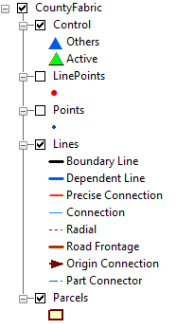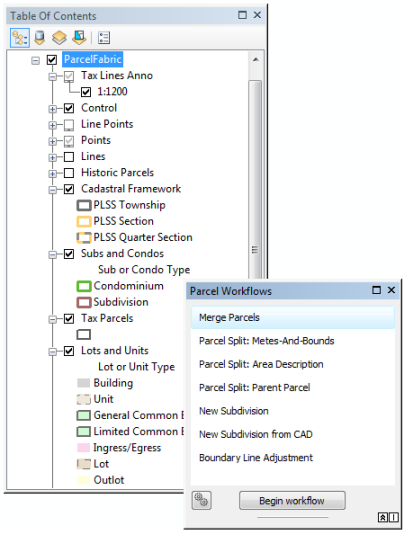Available with Standard or Advanced license.
The parcel fabric is added as a group layer to ArcMap. The internal feature classes that comprise a parcel fabric are represented as sublayers under the parcel fabric group layer.
The parcel fabric group layer is composed of the following set of sublayers:
- Control points
- Line points
- Points
- Lines
- Parcels

A parcel fabric group layer behaves in the same way as a regular group layer in ArcMap, but layers cannot be added to, or removed from, the parcel fabric group layer.
Each sublayer of the parcel fabric layer can be queried and displayed in the same way as normal feature layers in ArcMap. You can right-click each sublayer to display its attribute table. In each sublayer's attribute table, all nonsystem-managed attributes are editable. System-managed attributes, such as FromPointID and ToPointID on the Lines table, are locked and are not editable. The nonsystem-managed attributes of individually selected parcel features can also be edited in the Attributes window. The Attributes window  is located on the Editor toolbar.
is located on the Editor toolbar.
Parcel fabric sublayers can also be individually added to ArcMap as stand-alone layers.
Control sublayer
The Control sublayer displays control points in the parcel fabric. By default, control points are displayed by their active status. A control point is active if it is turned on in the Control dialog box and is connected to a parcel fabric point. A control point is inactive if it is not connected to a parcel fabric point.
LinePoints sublayer
The LinePoints sublayer displays line points and is turned off by default. Line points are added to parcel points that lie on the boundary lines of adjacent parcels. A line point allows a parcel point to lie on an adjacent boundary line without splitting the boundary line. Furthermore, a line point constrains the parcel point to lie on the adjacent boundary line and maintains topological integrity. Through the use of line points, parcel lines can correctly represent the legal record, where each adjacent boundary line stores and displays the correct dimension.
Points sublayer
The Points sublayer displays parcel points and is turned off by default. Parcel points store x,y,z coordinates, which are initially generated when parcel data is either loaded or joined to the parcel fabric. The x,y coordinates can be adjusted in a parcel fabric least-squares adjustment.
Parcel points represent parcel corners, curve center points, and end points of connection lines. Points should be common between shared boundaries and should not be duplicated.
Lines sublayer
Parcel lines represent the boundaries of parcel fabric parcels. Parcel lines store COGO dimensions, which should ideally or eventually match recorded dimensions on the record of survey or plan. Parcel lines are not only boundary lines, they can also be connection lines and radial lines.
By default, parcel lines are symbolized using the following parcel fabric line categories:
- Boundary Line (Category 0)—Represents the boundary of a parcel or unclosed parcel in the parcel fabric.
- Dependent Line (Category 1)—Represents lines that are dependent on parcel boundary lines, for example, easement lines. Dependent lines do not define the boundaries of parcels; that is, a closed loop of dependent lines will not create a parcel.
- Precise Connection (Category 2)—Represents a line that connects a parcel point to a closely located control point. In the least-squares adjustment, precise connection lines place the control point on top of the connected parcel point. Precise connection lines should start at the parcel point and end at the control point and should never start at the control point, that is, be oriented in the reverse direction.
- Connection (Category 3)—Represents lines that connect parcel points across right-of-ways and connect parcel points to control points. Connection lines are used to add connectivity to the parcel fabric to form a network that can be adjusted in a fabric least-squares adjustment. Connection lines do not define the boundaries of parcels; that is, a closed loop of connection lines will not create a parcel.
- Radial (Category 4)—Represents lines that radiate out from the end points of curves to the center points of curves. Radial lines are automatically generated and maintained for curved boundaries. Radial lines are only displayed when a parcel is opened.
- Road Frontage (Category 5)—Represents the boundaries of parcels that lie adjacent to roads or right-of-ways. When creating a new parcel, you could use the Road Frontage category rather than the Boundary category for parcel lines that lie along roads.
- Origin Connection (Category 6)—Represents lines that connect a point of beginning to the starting point of a parcel. When creating a new parcel, an origin connection line is always entered first, then the remaining traverse lines of the parcel are entered.
- Part Connector (Category 7)—Represents lines that connect the parts and/or rings of a multipart or donut parcel. Part connection lines are automatically generated when multipart or donut parcels are migrated to a parcel fabric. When creating a multipart or donut parcel, part connection lines are used to connect parts and/or rings.
Parcels sublayer
The Parcels sublayer displays parcel polygons. Parcels in the parcel fabric are defined by a closed sequence of traverse lines. Parcels can also be unclosed, for example, a road centerline. An unclosed parcel allows a feature such as a road centerline to be maintained and represented as an individual entity in the parcel fabric and not be dependant on another parcel.
Parcels can also be multipart, singlepart, or donut/island parcels.
Parcel fabric layer enabled with the Local Government Information Model
When a parcel fabric is enabled with the Local Government Information Model (LGIM), it becomes optimized for parcel editing in the United States. The parcel fabric layer is configured to display tax parcels, subdivisions, lots, and encumbrances and is streamlined for common parcel editing workflows. Parcel types, attributes, and domains that reflect the editing requirements of local government parcel maintenance are added to parcel fabric tables. Automated parcel editing workflows are available on the Parcel Editor menu.

Learn more about enabling the parcel fabric with the Local Government Information Model
Querying and displaying the parcel fabric layer
The parcel fabric group layer allows powerful query and display of the parcel fabric. Because parcel fabric feature classes and tables are internally related to each other, the parcel fabric sublayers can be queried with respect to each other. For example, parcels can be queried by their related lines. The following list describes some examples of querying parcels in the parcel fabric:
- Parcels can be queried and displayed by plan (record of survey).
- Parcels can be queried and displayed by line type, for example, road frontage.
- Parcels can be queried and displayed by accuracy level.
- Parcels can be queried and displayed by their misclose information, such as MiscloseRatio and MiscloseDistance.